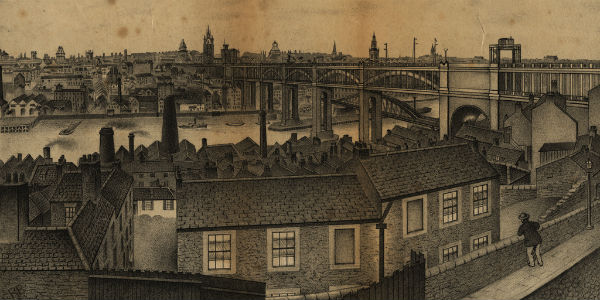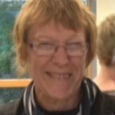Broken up and hollowed out: how the north-east lost its powers and influence
Following its heyday of political influence during the New Labour era, the north-east has seen much of its regional democracy decline or disappear – with the loss of 13 councils, nearly 500 councillors and the North East Assembly. Sue Regan, Fred Robinson and Keith Shaw have examined the approximately 100 elected and unelected bodies that govern the region for a new report, Who Runs the North East? While more women are involved (albeit not at a senior level), the picture is of a fragmented, confusing and often democratically unaccountable system which ordinary people struggle to understand.

View towards Newcastle-upon-Tyne from Gateshead by R Bates, 1887. Image: Newcastle Libraries. Public domain
The democratic deficit
One of the striking features of governance is how challenging it is to get to grips with an institutional landscape that is complex, confusing and not particularly accountable or democratic. The sheer number of governance bodies, the differences in status (elected, unelected or indirectly elected) and the lack of coterminosity (the situation when two organisations have the same boundaries) often defy public understanding. The labyrinthine nature of individual sectors such as the NHS leaves patients confused and lacking understanding as to how decisions – such as hospital ward or GP surgery closures – are made. The increasingly fragmented system has an inbuilt ‘bias against understanding’, which leads to widespread ignorance of how things work, who is in charge and where real power lies.
What is also noticeable is how few of the decision-makers are directly elected and can be voted out of office. Apart from MPs, local councillors and police and crime commissioners, many public services are run by people who are appointed, so there is little democratic input. Indeed, although members of the public seem not to have noticed, there has been a diminution in local democratic capacity as there are far fewer local politicians than there used to be (largely because district councils in Northumberland and County Durham have been abolished). The north-east now has 12 councils led by 770 councillors – down from 25 councils and 1,279 councillors before 2009.
In the appointed sector (such as the NHS) the boards of Clinical Commissioning Groups and Foundation Trusts are appointed, and that’s also the case with the boards of FE colleges, universities, the bodies that invest public money in arts, heritage, culture and sport, and housing associations. Indeed, in many cases new board members are chosen (in secret) by the existing board members, who tend to select people in their own image.
How well are women and minorities represented in the north-east?
In terms of ‘representativeness’, there has been a noticeable increase in the involvement of women in elected north-east governance. Now, 14 of the region’s 29 MPs are women, compared with four women out of 30 MPs in 2000. They now amount to 48% of the region’s MPs, well above the national figure of 32%. It is the same on councils: 43% of north-east councillors are women, compared with 23% in 2000. Much of that change is attributable to the Labour party’s use of all-women shortlists when choosing candidates for elections. However, the glass ceiling has not disappeared: it has been ratcheted up. Ten of the 12 council leaders and 83% of the leaders and deputies are men, and that, in turn, distorts the gender composition of those local boards and partnership organisations that have senior councillors on their boards. Similarly, and despite some improvements since 2000, men continue to dominate the appointed state. It is still the case that almost all boards have a male majority; examples of a female majority are rare. In the NHS, for example, only one out of 21 organisations in the North East has more women than men on its board, while only one out of 19 further education colleges has a governing body consisting of more women than men.
In other respects, the people who run the north-east are far from representative of the population. Very few are under the age of 45; very few are from Black, Asian or Minority Ethnic (BAME) backgrounds; and few are disabled. Seven of the region’s 12 councils have no BAME councillors. Two of the region’s five universities have no BAME governors. No less remarkably, hardly anyone running the region’s NHS organisations is disabled. Looking at the profiles of politicians and non-executive board members it is very clear that the north-east is now largely run by people with professional and ‘middle class’ backgrounds; they are the ‘usual suspects’. Working-class politicians, trade union representatives and ordinary ‘active citizens’ have almost disappeared.
The north-east’s declining influence
Compared to the heady days of the late 1990s and 2000s, the north-east has very little influence. At the turn of the century, Labour was in power and the north-east’s MPs included Tony Blair. Of the 22 members of the Cabinet at that time, six were from the region. Now, only one regional MP is a junior government minister in the post-2017 Conservative administration. The main regional structures – the Regional Development Agency, Government Office, and the North East Assembly – have all been abolished. Despite the rhetoric there is now very little devolution of power to the regional or sub-regional level. Local government has been weakened by years of austerity – and that’s on top of a continuing problem of low election turnouts and a general lack of public interest in what councils do. Local democracy is at a low ebb.
Crucially, the region’s voice, resources and political identity have been fragmented into three – with the Tees Valley going its own way as a Combined Authority, soon to be joined by the ‘North of Tyne’ Deal (Newcastle, Northumberland and North Tyneside), leaving the four remaining north-east councils to decide their own fate. Many feel that the demise of the traditional regional boundaries may threaten the viability of the old idea of the ‘Scottish borders to Teesside’ north-east, and leave the remodelled region heavily dependent on centrally-defined deals with strings attached and on the chimera that is the Northern Powerhouse (or the Manchester Powerhouse, as it is viewed from the north-east). A better bet may well be to look again at formal constitutional changes that would bring a new federal settlement for the regions of England – even including a directly-elected assembly for the north-east!
This post represents the views of the authors and not those of Democratic Audit. It is based on Who Runs the North East Now? Governance and Governing in an English Region, written by the authors and supported by the Joseph Rowntree Charitable Trust, the Newcastle law firm Muckle LLP and the Institute for Local Governance.
 Fred Robinson is a Professorial Fellow of St Chad’s College, Durham University.
Fred Robinson is a Professorial Fellow of St Chad’s College, Durham University.
 Keith Shaw is Professor of Politics at Northumbria University.
Keith Shaw is Professor of Politics at Northumbria University.
 Sue Regan is a doctoral student at Northumbria University.
Sue Regan is a doctoral student at Northumbria University.





 Democratic Audit's core funding is provided by the Joseph Rowntree Charitable Trust. Additional funding is provided by the London School of Economics.
Democratic Audit's core funding is provided by the Joseph Rowntree Charitable Trust. Additional funding is provided by the London School of Economics.